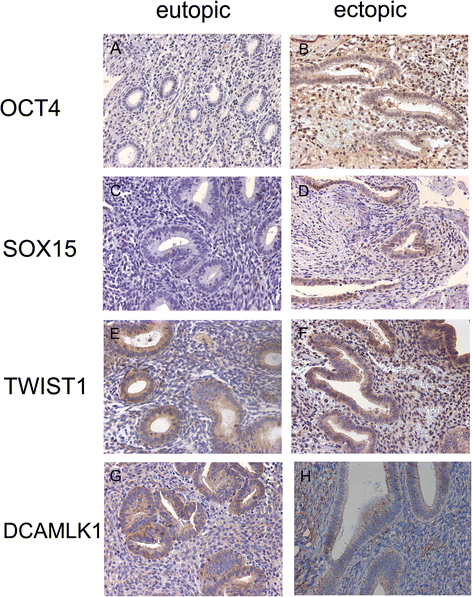Enhanced expression of the stemness-related factors OCT4, SOX15 and TWIST1 in ectopic endometrium of endometriosis patients
- PMID: 27881125
- PMCID: PMC5122168
- DOI: 10.1186/s12958-016-0215-4
Enhanced expression of the stemness-related factors OCT4, SOX15 and TWIST1 in ectopic endometrium of endometriosis patients
Abstract
Background: Current evidence suggests that endometrial-derived stem cells, spilled in the peritoneal cavity via retrograde menstruation, are key players in the establishment of endometriotic lesions. The aim of this study was to determine the presence and distribution of the stemness-related factors OCT4, SOX15, TWIST1 and DCAMLK1 in women with and without endometriosis.
Methods: Immunohistochemical analysis was used to determine stromal and epithelial expression of OCT4, SOX15, TWIST1 and DCAMLK1 in endometriosis patient (EP) endometrium (n = 69) and endometriotic tissue (n = 90) and in control endometrium (n = 50). Quantitative Real-Time PCR of OCT4, SOX15 TWIST1 and DCAMLK1 was performed in paired samples of EP endometrium and endometriotic tissue. Co-immunofluorescence staining was performed for OCT4 and SOX15. For statistical analyses we used unpaired t-test, Fisher combination test and Spearman test. For paired analyses, paired t-test and McNemar test were used.
Results: We detected a significant correlation between the expression of the established stem cell marker OCT4 and the stemness-related markers SOX15 (p < 0.001) and TWIST1 (p = 0.002) but not DCAMLK1. We showed a colocalization of SOX15 and OCT4 in epithelial and stromal cells of endometriotic tissue by coimmunofluorescence. A concordant expression of OCT4 and SOX15 in the same sample was observed in epithelial cells of the endometriotic tissue (71.7%). The expression of stemness-related factors was not associated with proliferative or secretory phase of the menstrual cycle in endometriosis patients but was found to be differentially expressed during the menstrual cycle in the control group. Increased expression of epithelial OCT4, SOX15 and TWIST1 was detected in endometriotic tissue compared to EP endometrium in paired (p = 0.021, p < 0.001 and p < 0.001) and unpaired analysis (p = 0.040, p < 0.001 and p = 0.001).
Conclusion: Our findings support the hypothesis that upregulation of stem cell-related factors contribute to the establishment of endometriotic lesions.
Trial registration: The study was approved by the institutional review board (545/2010 on 6th of May 2014) of the Medical University of Vienna ( http://ethikkommission.meduniwien.ac.at/fileadmin/ethik/media/dokumente/register/alle_2010.pdf ).
Keywords: Endometriosis; OCT4; SOX15; Stem cells; TWIST1.
Figures






References
MeSH terms
Substances
LinkOut - more resources
Full Text Sources
Other Literature Sources
Medical

